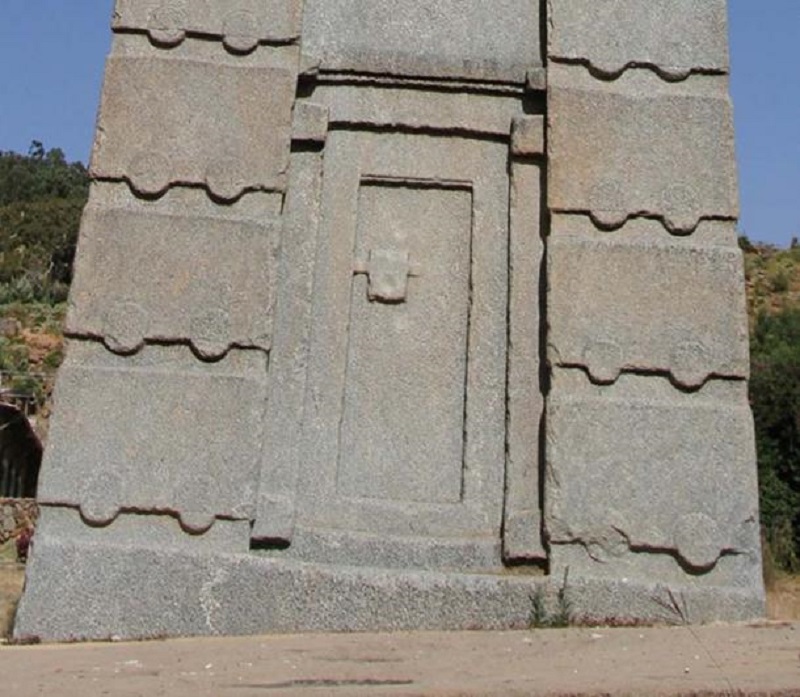For those familiar with the remarkable monoliths of Axum, Ethiopia, you will no doubt have noticed their uncanny resemblance to modern tower apartment buildings. Along with several other granite obelisks of similar design at Northern Stelae Park located in the northern highlands of Ethiopia, the Obelisk of Axum (above) is about 79 feet (24 meters) tall, weighs 160 tons and built from one block of stone. The solid granite block is said to have been quarried several miles away.
Obelisk’s building
It is understood to have been built in the 4th century AD by people living in the Kingdom of Aksum, an ancient Ethiopian civilization, but it is most likely much older than that, as the city Axum stretches back to 100 BC and as it happened. has been clearly established, we cannot date the stones so any proposed dates for the construction of the stelae are speculative.

Ethiopia – Aksum – Stelae Park – Axum Monument.( rudiernst / Adobe)
Experts suggest that their purpose was to serve as “markers” for underground burial chambers, which makes sense given that UNESCO found that “the site was a royal necropolis used by some dynasties before the Christian period”.
We also happen to be told by scholars that the larger monoliths represent tombstones intended only for royal burial chambers and were decorated with ‘multi-tiered false windows and doors, while the Lower nobility would have had smaller, less decorative windows.’
As the images reveal, the stele clearly shows fake windows and doors very reminiscent of those seen on modern apartment buildings. So if that is readily accepted by scholars and historians, then why is no one talking about the elephant in the room and that is WHY they look like modern tower blocks?
Close-up of the memorial with fake doors. (knovakov/Adobe)
Why is the Obelisk of Axum intricately carved to represent a nine-story building – with two fake doors at the base, including fake door handles and locks? What’s amazing is that each ‘floor’ of the building reveals a structurally supported frame next to the window, all of which suggests a modern construction.
The Obelisk is rebuilt
The Obelisk lay in ruins for hundreds of years only to be rediscovered in 1935 by Italian soldiers during the conquest of Ethiopia. It was then taken to Rome in three pieces and reassembled. After the end of World War II, the United Nations insisted that the stele be returned to Ethiopia and finally in 2007, after years of difficulty and delay, the Obelisk was finally released. to the original position.

Workers during the reinstallation of the Aksum Obelisk. (Eric00000007 / CC BY-SA 3.0 )
If the ancient Africans responsible for constructing the Axum Stele imitated the buildings they had seen, or simply commemorated their own Axumite buildings, that alone would be an incredible.
Similar buildings at present
If we consider that the first tower block built in the UK was the residential tower block called “The Lawn” (pictured below) built in Harlow, Essex in 1951, then one might ask how How could such an ancient and seemingly primitive civilization be like that? as the Axumite people took inspiration for the design work inherent in their granite blocks.
Lawns, Harlow New Town, Essex. (inside view / CC BY-SA 2.0 )
Just 67 years ago, the world’s first skyscraper was built in 1884-1885. The Chicago Home Insurance Building, now considered the “Father of Skyscrapers,” stands 10 stories tall, reaching a maximum height of 138 feet. This landmark building did not last long and was ironically demolished the same year, in 1931, when the Empire State Building in New York was completed.
However, what is interesting is that, although the Chicago building is known as the world’s first skyscraper, if we go deep into the remote valley in Yemen, to the city of Shibam (below), we will see a desert landscape dotted with high-rise buildings not unlike the high-rise buildings here. familiar cityscapes that we see in the modern era.
Vintage image of Shibam, Yemen. (javarman/Adobe)
After a major flood destroyed much of the existing settlement, people built 500 mud buildings in the 1530s, nearly 500 years ago. Ranging from 5 to 11 stories high, Shibam’s mud skyscrapers are known as the “Manhattan of the desert”.
Mimicking Soviet-style blocks found throughout the Arab world, the buildings would not seem so impressive if not for their extreme age and the ingenious construction methods required to construct them .
So it seems that the tower blocks in the Yemeni desert existed for hundreds of years before the West started building more modern versions, which became synonymous with wealth and power in the cities. largest in the world.
It seems even more feasible, therefore, that what the Ethiopian kings depicted with their pseudo-tower blocks thousands of years ago, may actually represent a forgotten and forgotten time in long history. The African continent holds many secrets and the ancient civilizations that flourished in the distant past may hold the key to many of the mysteries surrounding this most secretive continent.
This photo shows part of North Stelae Park in Axum, Ethiopia. On the left is the shattered remains of the Great Obelisk, on the right is the 27 meter high (some would say 23 meter high) obelisk known as “King Ezana’s Stele”. (Magnus Manske / CC BY-SA 2.0 )






